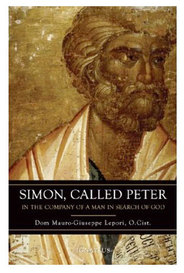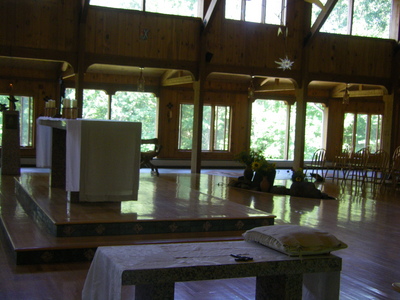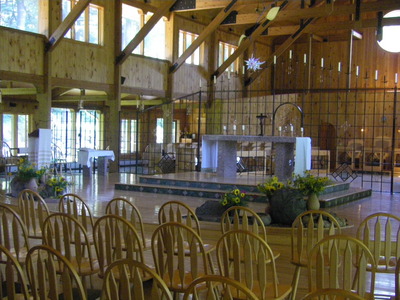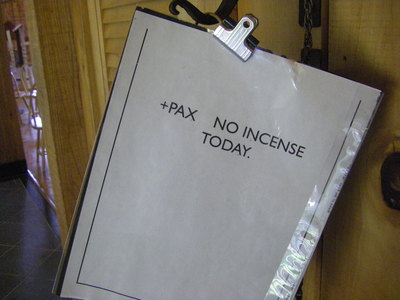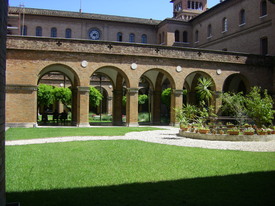 For a number of years now, when I am in Rome, I stay at the Benedictine Abbey of Sant'Anselmo on the Aventine Hill. The Benedictine monks have been on the Aventine since property was purchased from Pope Leo XIII in the late 19th century. Technically, Sant'Anselmo is not a functioning abbey as other abbeys with a stable monastic community but it's a house of studies for monks and others. There is an order for the day of prayer, Mass, study, and work but one does not become a monk of Sant'Anselmo as you would become a monk of Saint Vincent's. At the Anselmo you'll find a "permanent" faculty and staff, and a group of monks who work in the Abbot Primate's offices and some monks who work at other universities or at the Vatican, but no monk vows stability to Sant'Anselmo.
For a number of years now, when I am in Rome, I stay at the Benedictine Abbey of Sant'Anselmo on the Aventine Hill. The Benedictine monks have been on the Aventine since property was purchased from Pope Leo XIII in the late 19th century. Technically, Sant'Anselmo is not a functioning abbey as other abbeys with a stable monastic community but it's a house of studies for monks and others. There is an order for the day of prayer, Mass, study, and work but one does not become a monk of Sant'Anselmo as you would become a monk of Saint Vincent's. At the Anselmo you'll find a "permanent" faculty and staff, and a group of monks who work in the Abbot Primate's offices and some monks who work at other universities or at the Vatican, but no monk vows stability to Sant'Anselmo.Benedictines: September 2010 Archives
 For a number of years now, when I am in Rome, I stay at the Benedictine Abbey of Sant'Anselmo on the Aventine Hill. The Benedictine monks have been on the Aventine since property was purchased from Pope Leo XIII in the late 19th century. Technically, Sant'Anselmo is not a functioning abbey as other abbeys with a stable monastic community but it's a house of studies for monks and others. There is an order for the day of prayer, Mass, study, and work but one does not become a monk of Sant'Anselmo as you would become a monk of Saint Vincent's. At the Anselmo you'll find a "permanent" faculty and staff, and a group of monks who work in the Abbot Primate's offices and some monks who work at other universities or at the Vatican, but no monk vows stability to Sant'Anselmo.
For a number of years now, when I am in Rome, I stay at the Benedictine Abbey of Sant'Anselmo on the Aventine Hill. The Benedictine monks have been on the Aventine since property was purchased from Pope Leo XIII in the late 19th century. Technically, Sant'Anselmo is not a functioning abbey as other abbeys with a stable monastic community but it's a house of studies for monks and others. There is an order for the day of prayer, Mass, study, and work but one does not become a monk of Sant'Anselmo as you would become a monk of Saint Vincent's. At the Anselmo you'll find a "permanent" faculty and staff, and a group of monks who work in the Abbot Primate's offices and some monks who work at other universities or at the Vatican, but no monk vows stability to Sant'Anselmo.This week in Rome the Communio Internationalis Benedictinarum (CIB) for a congress, their 6th, on "Hope in Benedictine Spirituality."

Benedictine nuns and sisters from Europe, Africa and America are attending the meeting. The CIB is meeting on the Aventine Hill at the Primatial Abbey of Saint Anselm (known in Italian as Sant'Anselmo), home to the Abbot Primate , Notker Wolf (pictured left) who heads the confederation of Benedictine monks and nuns, the Pontifical Liturgical Institute, the Mabillion Institute and the college for theological studies for those preparing for ordination, earning degrees in theology and monastic studies (the general link for all these institutes for higher learning is here).
Zenit ran an interview today with Sister Maricarmen Bracamontes de Torreon, a Benedictine sister from Mexico who talked to aspects of hope and how understanding this virtue is key in Benedictine spirituality, and thus for all Christians. Sacred Scripture instructs us to look at how God works with us, that is, He gazes on us with faithfulness, compassion and mercifully. Looking to the holy Rule, Saint Benedict tells us "not to despair of God's mercy" (4.74). Sister Maricarmen said the participants are keenly aware that there is "only one Benedictine heart beats at the bottom of our universal diversity, and on the other, there is no doubt that we are going through a historical moment of darkness and we need a light, precisely like St. Benedict, which shines on high and gives us clarity in the midst of darkness."
Two questions of the interview are worth thinking about here on the Communio blog:
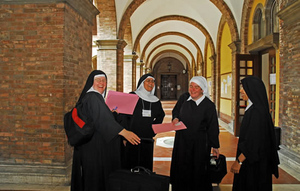
ZENIT: Can we then speak of a reflection from a holistic-rational perspective?
Sister Bracamontes: The Benedictine way leads to a process of integration that embraces the different dimensions of the human conscience: cognitive (the mind), affective (the heart), ethics and morals (the will and all its capacities), religious (the soul).
This integration enables us to love in a unified way and it is the condition to advance on the path of conversion. "However, the workshop where we must practice all these things diligently is the enclosure of the monastery and stability in the community" (Rule of Benedict, 4.78). The monastic dynamic animates the processes of integration in those who live in the "monastery," which is the place where we ask God with the most insistent prayers to bring to completion the divine work of our lives: that they all may be one.
If we persevere, trying to live in the "conversatio," the experience of God's unconditional love gradually integrates all the dimensions of our being, and thus we become unified in ourselves and in the diversity and plurality that characterizes us. The result of all this is that we live with transparency and consistency, that we do not separate our judgments from our feelings, or our conduct from our belief. In this way, our integrity and social and personal responsibility will not allow us "to say one thing and do another," or to establish ourselves in a life of contradictions and inconsistencies.
ZENIT: At present the Church is facing difficult moments. Does it call for hope?
Sister Bracamontes: Obviously. I think that some sectors of the Church have slipped up in the dialogue with the signs of the times that was so encouraged by the Second Vatican Council.
Those signs have revealed that for centuries, both in the society as well as the Church, efforts were dedicated to contain diversity and plurality, so characteristic of humanity. There are many human groups, with different views of reality; they are arriving on the first plane and ask that they be recognized, respected and integrated. The new methods of understanding and of discovery of humanity leave antiquated the old systems of relationship based on dominion, submission and marginalization. These systems of the past considered some human beings superior to others, based on race, gender, social class, ideology, religion, etc.
In face of a clearer awareness of the common dignity of all human beings, the absence of dialogue between those who are open to the signs of the times and those who continue to adhere to visions of the past and close their mind and heart to the historic change that we are experiencing, calls for hope.
From a perspective of faith, we are conscious and are convinced
that the whole of humanity, with its differences, has been created with equal
dignity in the divine image and likeness. We are children of God and sisters
and brothers among ourselves in Christ, who is our peace (Ephesians 2:14), and
in him all discrimination and marginalization is overcome (Galatians 3:26-28).
From this awareness we hear the call and we open ourselves with wisdom and
maturity to our world with its urgent need to recognize diversity, to promote
integration and to encourage dialogue and participation. Hence, many challenges
arise.

... it opens up and broadens the horizons of human awareness, pointing us beyond ourselves, bringing us face to face with the abyss of Infinity, can become a path towards the transcendent, towards the ultimate Mystery, towards God. Art, in all its forms, at the point where it encounters the great questions of our existence, the fundamental themes that give life its meaning, can take on a religious quality, thereby turning into a path of profound inner reflection and spirituality. This close proximity, this harmony between the journey of faith and the artist's path is attested by countless artworks that are based upon the personalities, the stories, the symbols of that immense deposit of "figures" --in the broad sense-- namely the Bible, the Sacred Scriptures. The great biblical narratives, themes, images and parables have inspired innumerable masterpieces in every sector of the arts, just as they have spoken to the hearts of believers in every generation through the works of craftsmanship and folk art, that are no less eloquent and evocative.
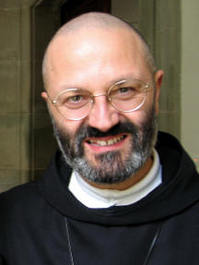 The General Chapter of the Order of Cistercians elected Dom Mauro-Giuseppe Lepori, 52, as their new Abbot General, succeeding Abbot Mauro Estevez. It is reported that Lepori received 109 of 134 votes. His work as abbot general will last for the next 10 years with about 1700 monks and nuns of the Order of Cistercians throughout the world.
The General Chapter of the Order of Cistercians elected Dom Mauro-Giuseppe Lepori, 52, as their new Abbot General, succeeding Abbot Mauro Estevez. It is reported that Lepori received 109 of 134 votes. His work as abbot general will last for the next 10 years with about 1700 monks and nuns of the Order of Cistercians throughout the world.